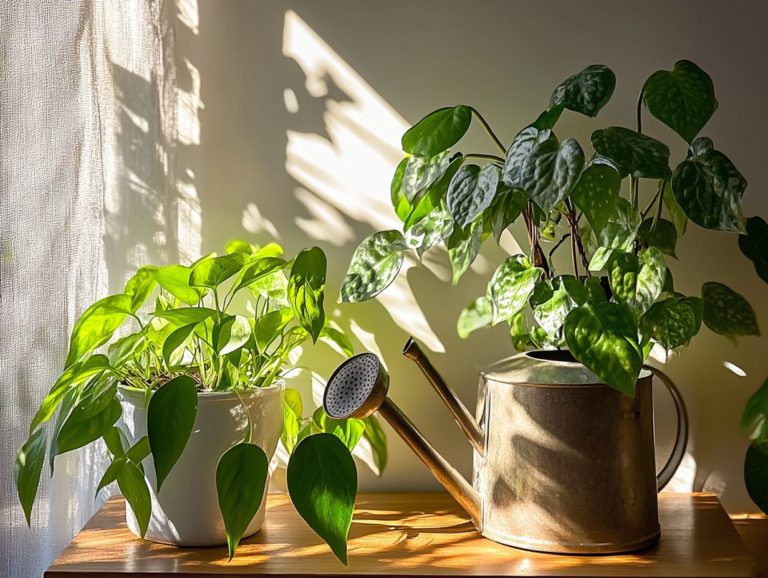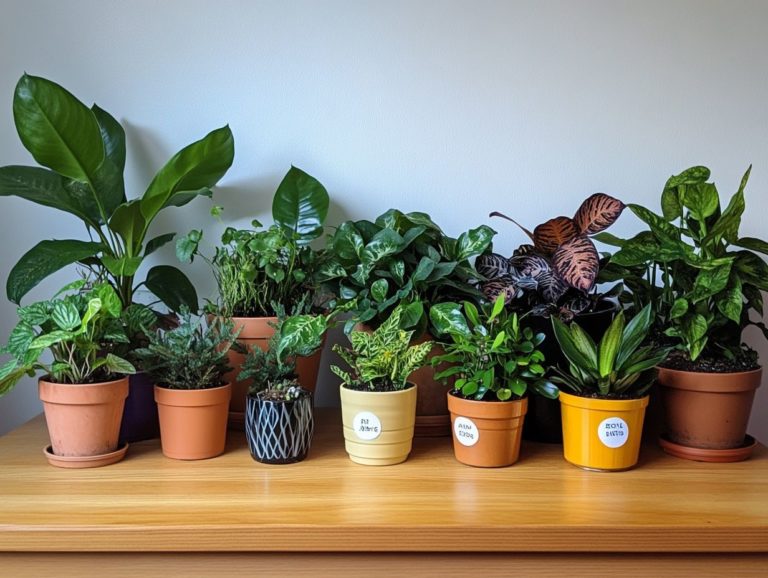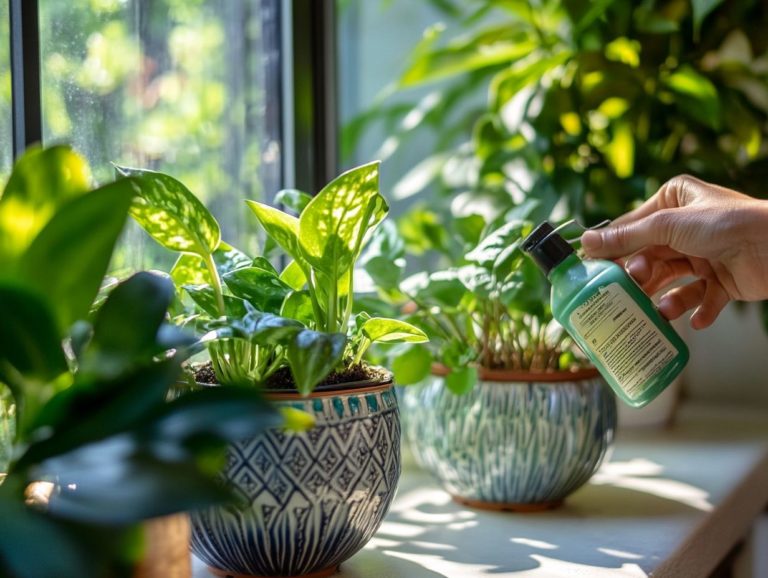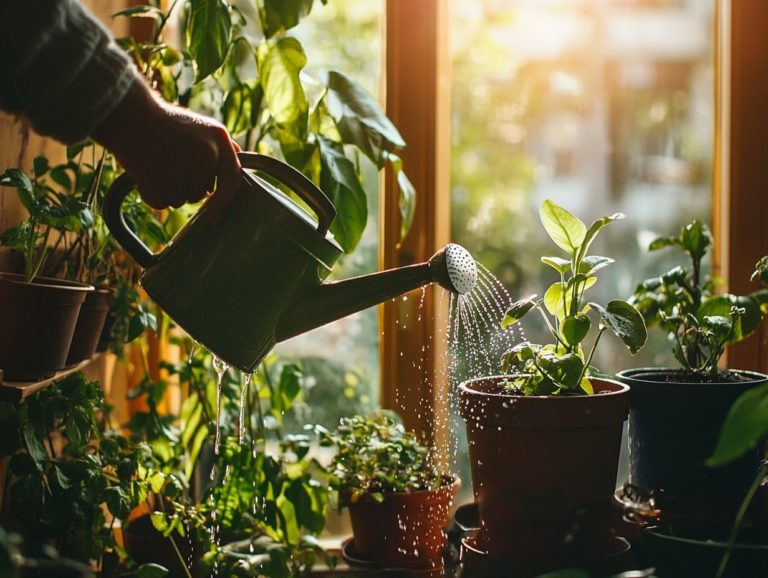What Soil is Best for Indoor Plants?
Choosing the right soil for your indoor plants is essential for their growth and overall health. The best soil can significantly impact how well your plants thrive, affecting crucial factors like drainage, aeration, and nutrient availability.
With a myriad of options available ranging from potting mixes to organic and inorganic compositions understanding what works best for your specific plant needs becomes vital. This guide will delve into the various types of soil, key considerations for selection, proper potting techniques, and tips for maintaining healthy soil, ensuring that your indoor garden flourishes beautifully.
Contents
- Key Takeaways:
- The Importance of Choosing the Right Soil for Indoor Plants
- Types of Soil for Indoor Plants
- Factors to Consider When Choosing Soil
- How to Prepare and Use Soil for Indoor Plants
- Common Mistakes to Avoid When Using Soil for Indoor Plants
- Frequently Asked Questions
- What is the best soil for indoor plants?
- How often should I repot my indoor plants?
- What signs indicate my plant needs more water?
- Can I use regular garden soil for my indoor plants?
- What is the difference between potting mix and potting soil?
- Should I use fertilizer in my indoor plant soil?
- How often should I repot my indoor plants?
- Can I reuse potting mix for my indoor plants?
Key Takeaways:
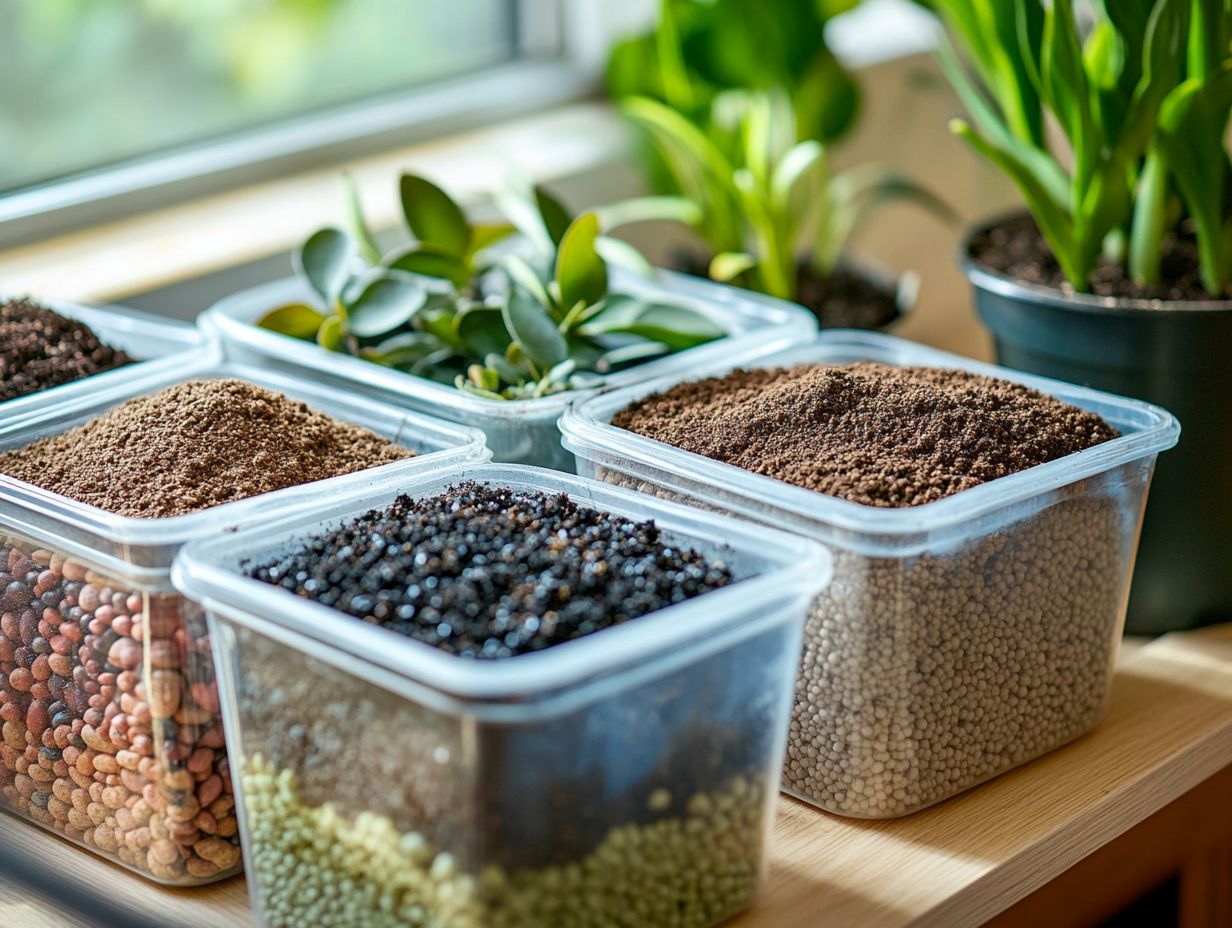
- Choosing the right soil is crucial for the growth and health of indoor plants!
- Potting mixes are recommended over garden soil for indoor plants, and organic soil is preferred for its benefits.
- Consider factors like plant needs, drainage, and aeration when selecting soil. Follow proper potting techniques and avoid overwatering or using the wrong soil type.
The Importance of Choosing the Right Soil for Indoor Plants
Are you looking to help your indoor plants thrive? Selecting the right soil for your indoor plants is essential for their growth and vitality. The ideal soil offers important nutrients, the best water retention, and proper drainage key elements for all houseplants, from lush foliage to resilient succulents and cacti.
The potting mix you choose can profoundly impact the pH levels and organic matter within the soil, ultimately enhancing your plants’ chances of survival and flourishing.
When embarking on your indoor gardening journey, prioritizing a high-quality potting mix rich in essential components like peat moss and decomposed plant material that helps retain moisture, along with perlite, a volcanic glass that improves aeration, will set the stage for your plants to thrive in a carefully controlled environment. If you’re looking for easy-to-care-for options, check out the best indoor plants for beginners.
How Soil Affects Plant Growth and Health
The quality of the soil plays a crucial role in determining the growth and health of your plants. It affects water retention, nutrient availability, and even helps prevent root rot.
Different soil types sandy, clay, and loamy each come with their own set of characteristics that can significantly influence these factors. For example, sandy soil drains quickly, which can be a blessing but also means you’ll need to manage it carefully to ensure adequate moisture. On the flip side, clay soil retains water exceptionally well but can become compacted, restricting your plants’ roots from accessing the oxygen and nutrients they need.
To enhance soil quality and promote optimal plant health, consider incorporating organic matter like compost or well-rotted manure. It provides essential nutrients and improves soil structure. By maintaining a nutrient-rich environment that is free from compaction, you can support better water retention and ultimately encourage robust growth in your plants.
Types of Soil for Indoor Plants
Understanding the different types of soil available for indoor plants is crucial for cultivating the perfect environment for your greenery. This includes specialized potting mixes, such as cactus mix and succulent mix, specifically designed to cater to the unique needs of each plant type.
Potting Mixes vs. Garden Soil
Understanding the distinction between potting mixes and garden soil is essential for your indoor gardening success. Potting mixes are specifically designed for container growth, while garden soil is tailored for outdoor applications.
These two mediums vary significantly in composition. Potting mixes often feature a blend of peat moss, vermiculite, and perlite, which provides superior aeration and drainage—crucial factors in preventing root rot for your potted plants. Garden soil typically consists of topsoil, clay, and organic matter, resulting in a heavier and denser mixture that can retain too much moisture for container gardening. Additionally, understanding what is the best temperature for indoor plants can further enhance their growth and health.
This unique characteristic of potting mixes makes them particularly suitable for houseplants, as they meet the diverse water and nutrient requirements of various species, fostering a thriving indoor ecosystem. Understanding why soil quality matters for indoor plants, potting mixes are less likely to introduce pests and diseases, giving you a clean slate to nurture your indoor greenery with confidence.
Organic vs. Inorganic Soil
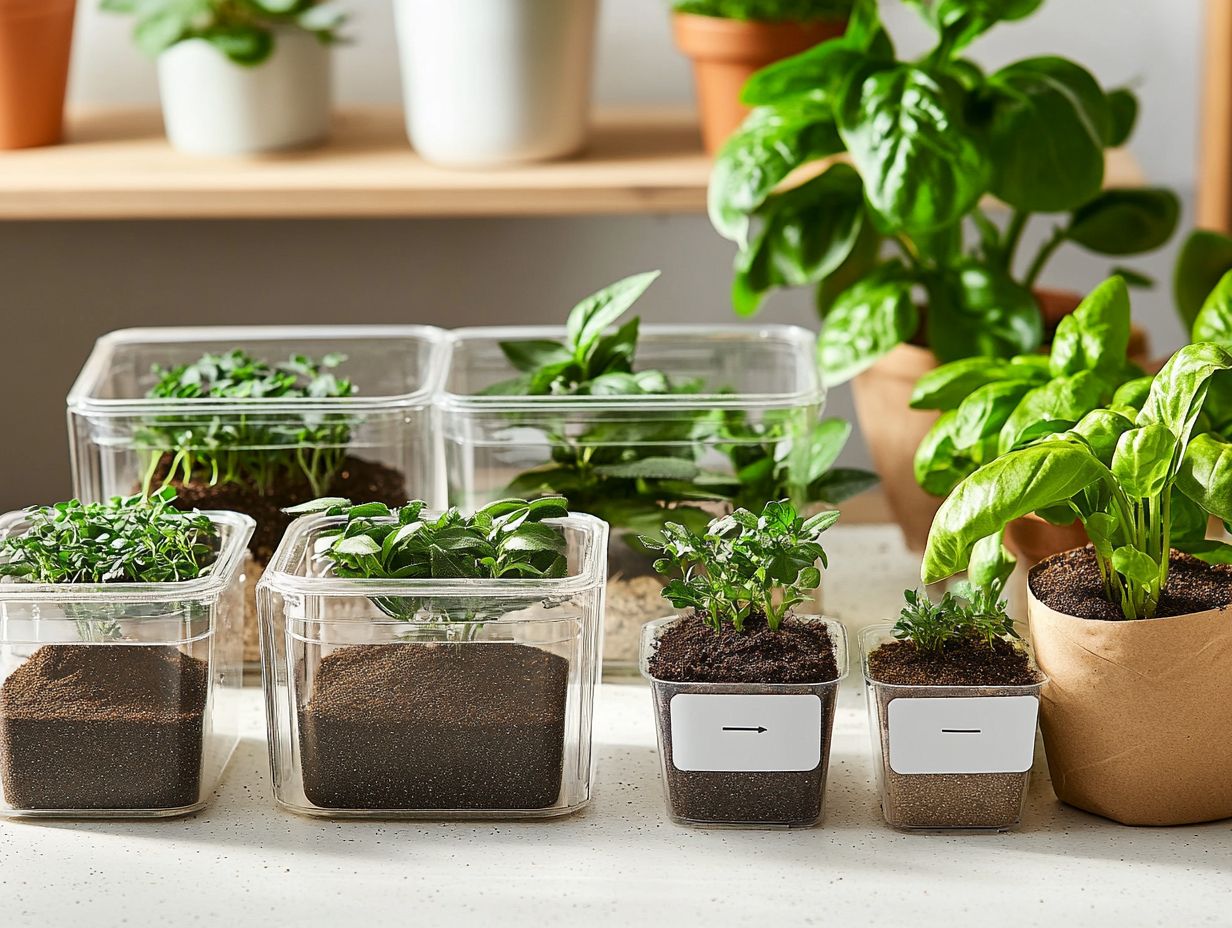
When you re choosing soil for your indoor plants, grasp the distinctions between organic and inorganic soil. Each type offers unique advantages for various plant needs, especially concerning nutrients.
Organic soil is rich in decomposed materials. It supplies essential nutrients and enhances water retention.
This is particularly beneficial for moisture-loving plants like ferns and herbs. However, if not managed properly, organic soil can host pests or diseases.
In contrast, inorganic soil typically contains synthetic components. It excels in drainage and aeration, making it ideal for succulents and cacti.
While inorganic options may lack nutrient diversity, they can be easily enhanced with fertilizers. This provides a controlled nutrient delivery system.
Factors to Consider When Choosing Soil
When selecting soil for your indoor plants, consider several important factors. Drainage is essential to prevent waterlogging, and good aeration ensures roots receive the oxygen they need.
It s crucial to consider each plant’s specific needs to create a thriving indoor garden.
Plant Type and Needs
Understanding the specific type of plant you are caring for is essential. Each species has unique requirements regarding moisture levels and soil composition.
Moisture-loving plants thrive in soil that retains water. They often need well-draining mixes enriched with organic matter.
In contrast, cacti and succulents need a sandy or gravelly soil mix for rapid drainage. This prevents root rot and supports their growth.
Choosing the right soil guarantees your plants receive optimal moisture levels. This choice significantly enhances their health and vitality.
Drainage and Aeration
Good drainage and aeration are vital to prevent root rot. These factors help maintain a perfect balance of moisture and air, promoting robust root development.
Different soil types affect drainage and aeration. For example, sandy soil allows excess water to escape and provides air pockets for roots.
Conversely, heavier soils like clay retain moisture, which can harm plant roots. Aim for a mix that includes perlite or vermiculite for better results.
How to Prepare and Use Soil for Indoor Plants
Preparing soil for your indoor plants requires knowledge of proper potting techniques and the right ingredients. Keeping the soil healthy is essential for your plants’ growth.
Proper Potting Techniques
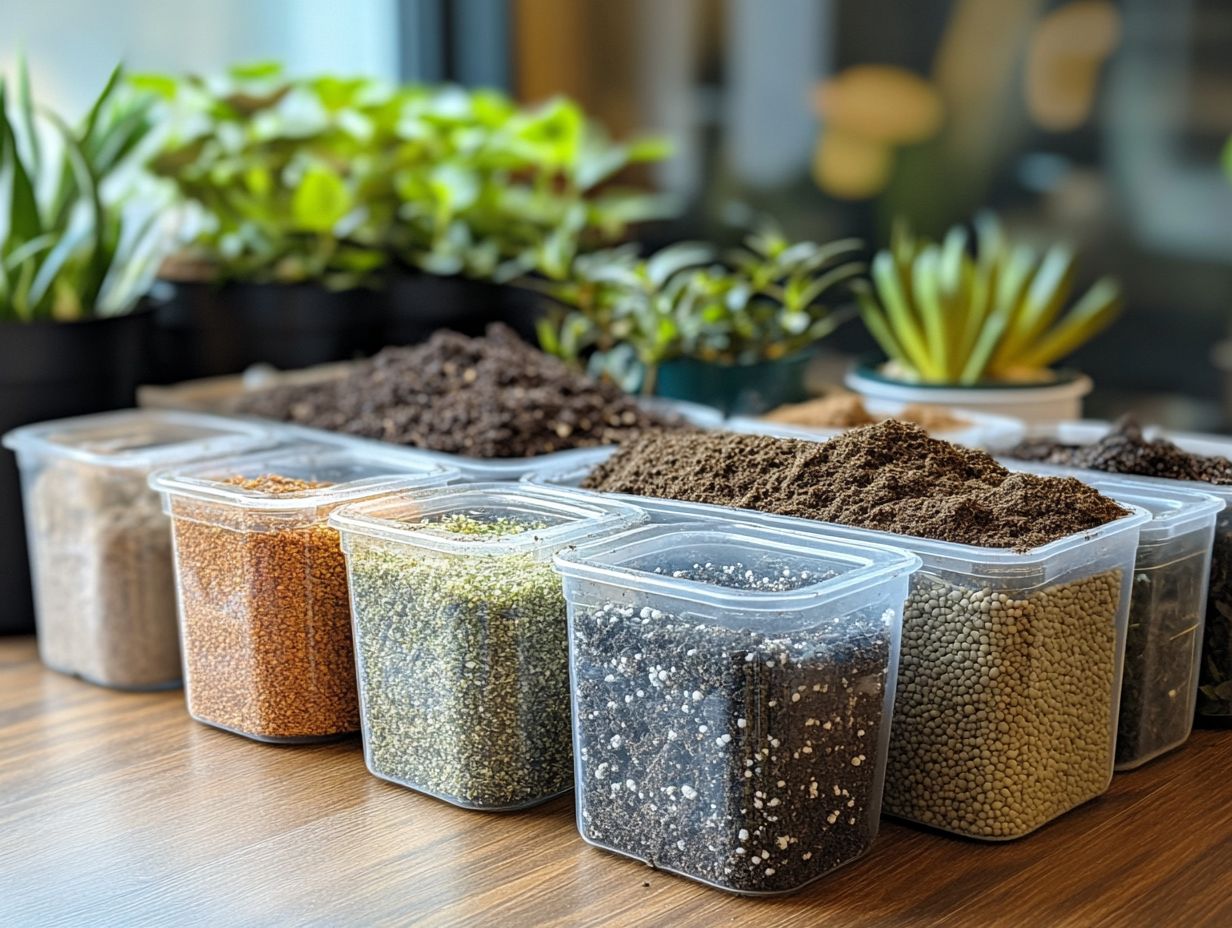
Employing proper potting techniques is vital to help your plants establish healthy roots and thrive in their new environment.
Taking the time to select an appropriate potting mix is equally important; it should provide adequate drainage while retaining the necessary moisture for roots to flourish. Consider the specific needs of your plant species, as different plants may require unique blends. For succulents, it’s essential to know what to know about soil, as some might thrive in mixes enriched with organic matter, while others are better suited for those formulated specifically for succulents and cacti.
Understanding the significance of repotting is essential. It allows for root space expansion and refreshes nutrient availability. Following best practices, such as watering appropriately and using pots with drainage holes, can significantly enhance your plants’ growth and vitality.
Tips for Maintaining Healthy Soil
To maintain healthy soil for your indoor plants, adopt consistent care practices that focus on soil improvement, moisture levels, and appropriate fertilization.
Incorporating organic materials like compost regularly enriches the nutrient profile and enhances soil structure. This creates an ideal environment for roots to thrive. Monitoring moisture levels is crucial; overwatering can lead to root rot, while underwatering may leave your plants parched. A moisture meter is a handy tool to measure how wet the soil is, simplifying this task.
Selecting the right type of fertilizer tailored to the specific needs of your plants promotes optimal growth. By prioritizing these practices, you can cultivate a vibrant garden filled with robust, nourished plants that flourish.
Common Mistakes to Avoid When Using Soil for Indoor Plants
Avoiding common mistakes when using soil for your indoor plants is essential for promoting their health and longevity.
Pay attention to issues like overwatering and selecting the right type of soil, as these factors can make all the difference in nurturing thriving plants.
Overwatering and Underwatering
Both overwatering and underwatering can profoundly affect the health of your indoor plants, leading to root rot or stunted growth.
When your plants receive too much water, their roots may become waterlogged, depriving them of essential oxygen and resulting in root rot. Conversely, if you’re not watering enough, you might notice signs of stress, such as wilting or yellowing leaves.
To strike that perfect moisture balance, use well-draining potting soil and pots that have drainage holes. Regularly checking the top inch of soil is a smart move; if it feels dry to the touch, it’s time to give your plants a drink.
A moisture meter can be a game-changer, providing a reliable way to gauge soil moisture levels and ensuring your plants receive just the right amount of water for optimal growth.
Using the Wrong Type of Soil
Using the wrong type of soil can seriously impede your plants’ growth and health. It may not cater to the specific needs of each species, impacting nutrient availability and overall soil quality.
For instance, succulents flourish in well-draining soil that prevents moisture retention, while ferns crave a rich, moisture-retentive mix to thrive. If you plant a succulent in dense, heavy soil, you risk root rot and the demise of your plant. Conversely, for more insights on soil types, check out what to know about soil for houseplants, as placing a fern in overly dry or sandy conditions can stunt its growth and lead to wilting.
This highlights that selecting the right potting mix is not merely a preference; it s an essential step in meeting the unique requirements of different plants. Doing so ensures they receive the nutrients and support needed for vibrant, healthy growth.
Frequently Asked Questions

What is the best soil for indoor plants?
The best soil for indoor plants is a well-draining potting mix specifically formulated for indoor plants. It should have a balance of organic matter, nutrients, and aeration to promote healthy root growth.
How often should I repot my indoor plants?
It’s generally recommended to repot your indoor plants every 1-2 years or when you notice signs of root crowding.
What signs indicate my plant needs more water?
Signs that your plant needs more water include wilting, yellowing leaves, or dry soil on the surface.
Don’t wait! Start your indoor gardening journey now by implementing these tips and sharing your experiences in the comments!
Can I use regular garden soil for my indoor plants?
No, regular garden soil is not suitable for indoor plants. It is often too heavy and dense, leading to poor drainage and potential root rot.
Additionally, it may contain pests and diseases that can harm your indoor plants.
What is the difference between potting mix and potting soil?
Potting mix is a soilless blend made from organic materials like peat moss, coconut coir, and small particles called perlite. Potting soil, on the other hand, includes some natural soil mixed with organic matter.
Potting mix is lighter and fluffier, making it better for indoor plants.
Should I use fertilizer in my indoor plant soil?
Yes, indoor plants need nutrients to grow well. A quality potting mix may not provide enough nutrients over time.
Choose a balanced liquid fertilizer made for indoor plants, and follow the instructions for use.
How often should I repot my indoor plants?
Most indoor plants should be repotted every 1-2 years, depending on their growth. Signs that your plant needs repotting include roots coming out of the drainage holes or slow growth.
If water runs straight through the pot, it s time to repot. Select a pot that is one size larger and use fresh potting mix.
Can I reuse potting mix for my indoor plants?
Reusing potting mix is not recommended. It may contain pests, diseases, or depleted nutrients.
Using fresh potting mix during repotting is the best way to ensure your indoor plants stay healthy.

